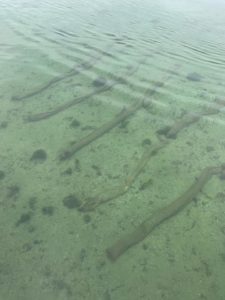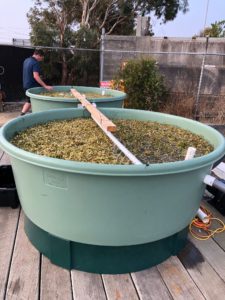 The Corner Inlet Broadleaf Seagrass Restoration Project is a world-first partnership between the commercial fishing industry based on Corner Inlet and the Yarram Yarram Landcare Network.
The Corner Inlet Broadleaf Seagrass Restoration Project is a world-first partnership between the commercial fishing industry based on Corner Inlet and the Yarram Yarram Landcare Network.
Members of the Corner Inlet Fisheries Habitat Association have contributed their boats, knowledge and expertise to assist with restoring areas of Broadleaf Seagrass (Posidonia australis) in Corner Inlet since 2017 and for good reason. The most important species of commercially-harvested fish in Corner Inlet, including rock flathead, King George whiting, gummy shark and Southern Calamari all rely on Broadleaf Seagrass for food or habitat at some point in their lifecycle.
The Corner Inlet-Nooramunga Marine and Coastal Park is home to about 7000 ha of Broadleaf Seagrass which underpins the productivity of the fishery. Around 25% of Corner Inlet’s seagrass meadows have been lost since the 1970s, but thanks to sustained efforts on-land to improve water quality in receiving catchments, the time is now right to restore broadleaf seagrass.
The project aims to restore about 200 hectares of Broadleaf Seagrass by 2030 using a range of different methods, first pioneered by Dr John Ford from the University of Melbourne. The addition of academic partners from the University of Western Australia, Dr John Statton and Prof Gary Kendrick has resulted in several additional techniques being implemented. Chief among these is the use of long hessian sandbag snakes (of about 2000mm x 80mm) which are placed on the bottom of Corner Inlet to create areas of tidal slackwater. This is an important measure to hold seagrass seeds in place.

The seeds are contained in a fruit pod which floats to the surface of Corner Inlet around Christmas time each year. Fishers act as the eyes on the Inlet and CIFHA members are responsible for identifying when long slicks – some greater than several kilometres in length – of seagrass fruit hit the surface and collect the pods with the assistance of the Yarram Yarram Landcare Network staff. The fruit pods are brought onshore and placed in tanks at Port Welshpool and the CIFHA-operated tank in Port Franklin. Over the course of some days the fruit shed a seed pod that is collected in the bottom of the tanks. These seeds are gathered and again head out on boats from which they are broadcast over the restoration sites. Millions of seeds will be collected over the course of the project.

Future steps for the project include translocating seagrass plugs using SCUBA divers and a membrane placed on the seeds to prevent the seeds from being dislodged out of their restoration sites. CIFHA members will be an integral part of future project outcomes.